Author: Alfred, LD Capital
Since July this year, the price of UNIBOT has been rising rapidly. According to coingecko’s data, the price of UNIBOT has increased from a low of $2.46 in May to a high of $236.98 in August, nearly 100 times growth, leading a wave of Telegram bots. Currently, the price of UNIBOT has fallen to around $100, and the prices of other targets have also fallen from their highs. Whether these bots projects are just a flash in the pan or will evolve into a new track and explode again in the future, this article will summarize by analyzing three representative projects.
1. What are “Crypto” bots
In fact, Telegram bots are not a new concept. Telegram bots are small applications that run within Telegram. Users can interact with the bots through flexible interfaces, which can support users to communicate and perform almost any type of task or service. For example, using Telegram bots to replace entire websites, receive payments, create custom tools, create games, and build social networks.
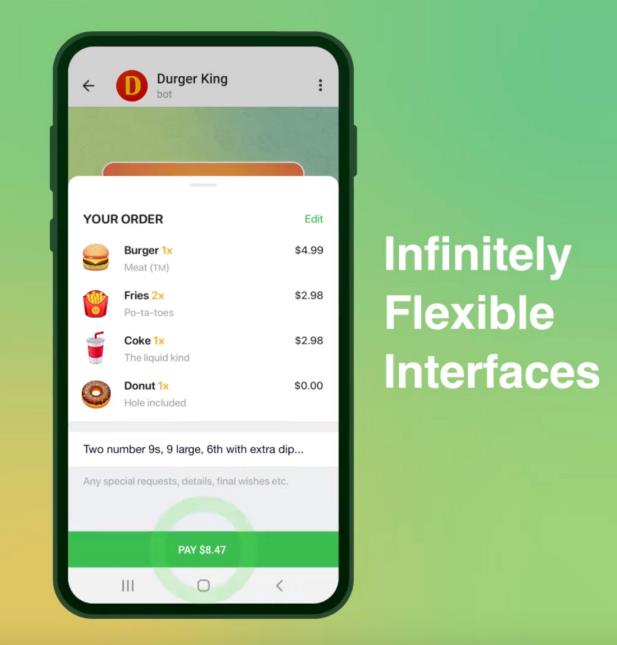
- KOL’s Self-narrative I made $10 million at the age of 22 after understanding the essence of cryptocurrency speculation.
- Understanding mBTC in 3 minutes A decentralized solution for Bitcoin cross-chain
- LD Capital Are the recent hot crypto bots a flash in the pan or a new investment track?
Source: Official Telegram (* The picture shows a mini program for ordering takeaway based on Telegram)
Thanks to Telegram’s open-source framework, since the birth of the crypto market, various bots based on Telegram have gradually emerged. For example, news bots that push important messages, bots that track changes in large on-chain addresses or token indicator fluctuations, etc. These bots used to serve users for free or for subscription fees.
Currently, in addition to Telegram-based bots, many bot-type dapps based on platforms such as Discord, Twitter, or directly on the web have also appeared. The characteristics of these bots are that they are specially designed to solve the needs of the crypto industry in an automated manner and incorporate the characteristics of the crypto market, such as designing dedicated token economics. Therefore, with the rapid development of bots in recent times, the author of this article prefers to call them “crypto” bots for the time being. This article divides “crypto” bots into three categories: trading bots, specialized tool bots (which solve specific types of problems other than trading), GPT and AI bots, and will analyze representative projects in each category.
2. Trading bot – Unibot
Unibot is a Telegram-based trading tool bot. Users can interact with the bot through Telegram to complete on-chain token trading activities on Uniswap in the form of conversation, such as token trading, limit trading, copy trading, sniper trading, private trading, etc. According to official information, the trading speed of this bot is 6 times that of Uniswap. In addition, Unibot has built an attractive profit-sharing mechanism, driving the price of the token to increase by hundreds of times.
Other projects of this type include Maestro (*no token yet), Banana Gun, Wagie Bot, Boltbot, NitroBot, 0xSniper, Dexbot, etc.
1. Core features
- Main menu and basic trading
When using it for the first time, please visit Unibot’s Telegram channel. After clicking “start”, Unibot will generate three wallets and pop up the main menu. Send at least 0.01 ETH to the wallet address to start trading. The main menu includes all the functions provided by Unibot, which can be accessed by clicking and chatting.
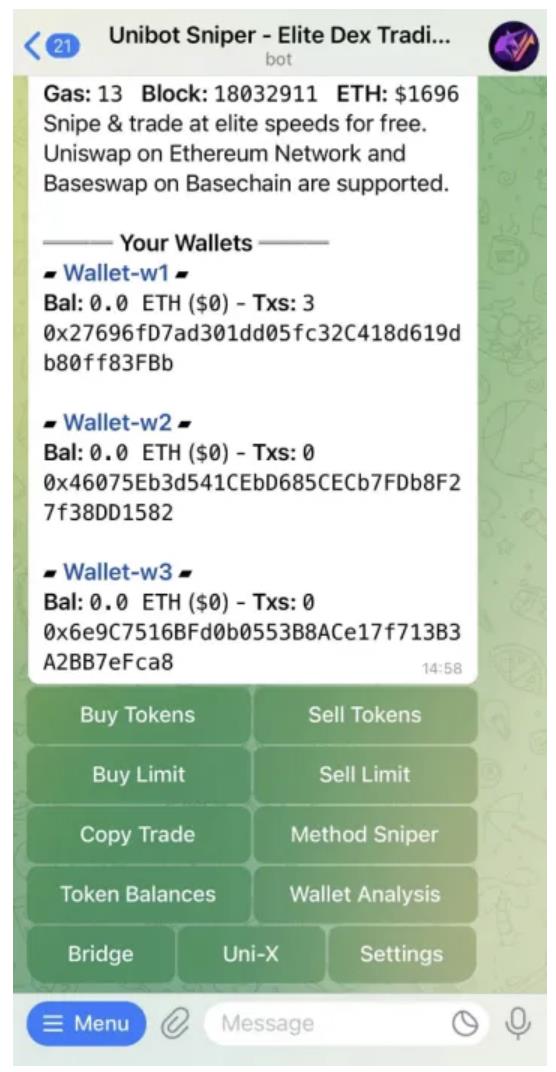
Source: unibot
- Limit Order Trading
Limit order trading can be achieved through chat dialogue. After customizing parameters such as the token contract address, purchase quantity, wallet selection, limit order duration, and limit order percentage, deployment can be completed.
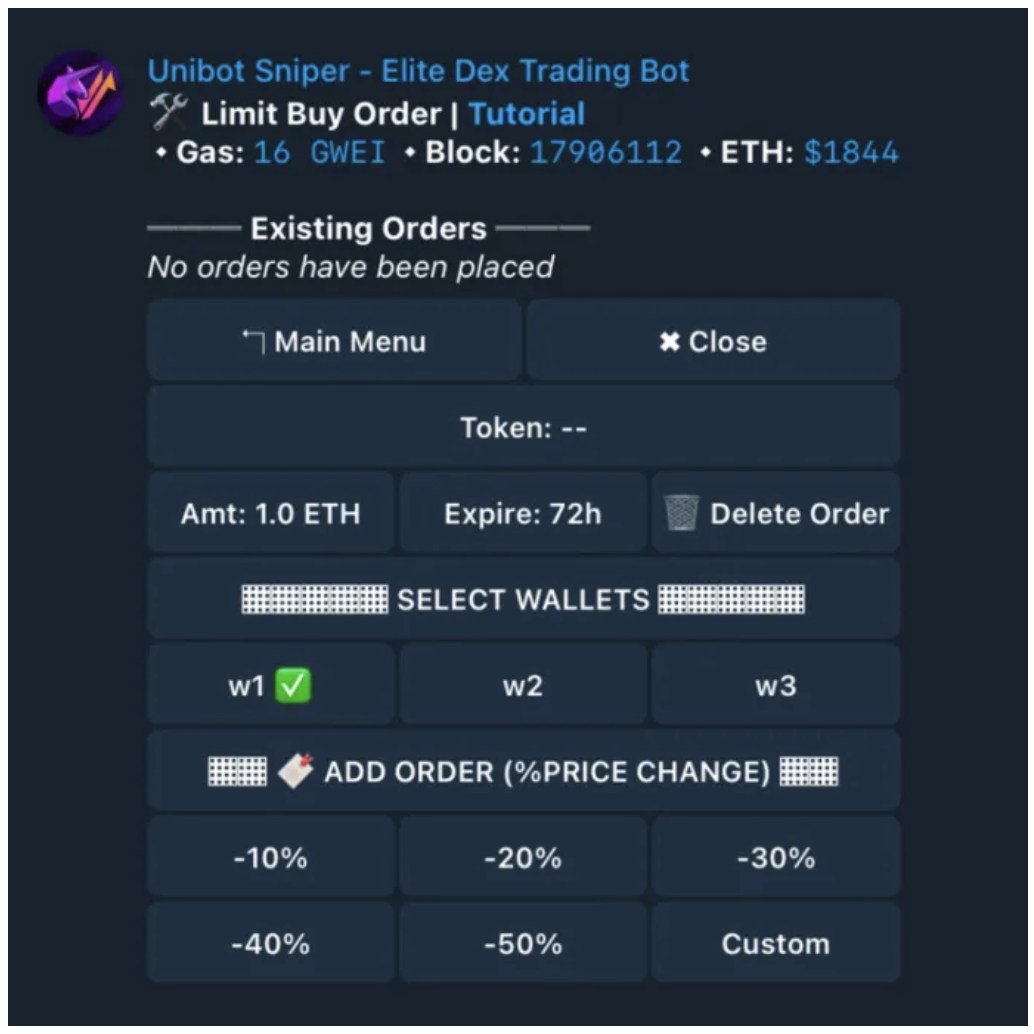
Source: Unibot Official
- Copy Trading
You can select professional traders and deploy automatic copy trading to replicate their trades. First, select the wallet you want to enable copy trading. Second, set the maximum amount of ETH for each copy trade. Third, add or delete addresses, you can enter one or more ETH addresses separated by commas.
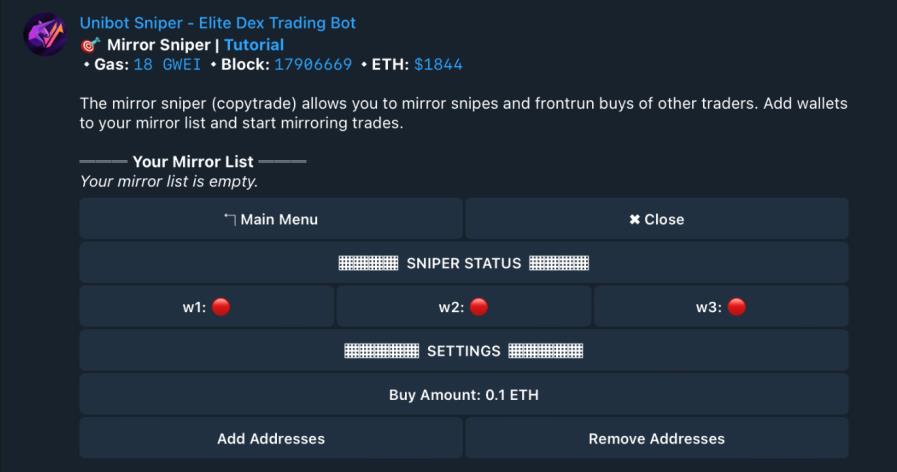
Source: Unibot Official
- New Token Sniping
This feature allows the bot to automatically purchase new tokens as soon as they are officially released. First, select the wallet you want to enable Method Sniper. Second, enter the address of the token you want to snipe. Third, set the maximum amount of ETH that can be used for each snipe and the highest gas price you are willing to pay. Fourth, set the relevant functions for token operations, such as enabling trading, adding liquidity, and starting trading. Fifth, set the maximum amount of tokens you are willing to buy and the number of blocks to wait before buying. Sixth, add to the snipe list to start. Unibot also provides an ERC-20 token deployment scanner (*unibotscanner) to quickly find and view new tokens.
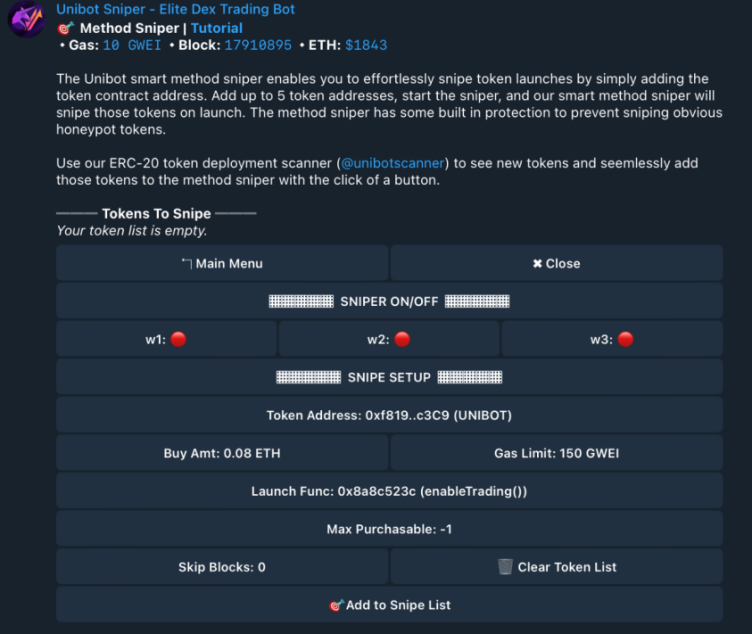
Source: Unibot Official
- Sell Protection
Enable Fail Guard to avoid losing gas fees. After enabling Fail Guard, the transaction will be simulated before broadcasting it to the network to ensure that it will not cause execution errors. The purpose of Fail Guard is to avoid wasting gas when sending transactions that are expected to fail. This setting adds some delay to your transactions because the simulation must be completed before executing the transaction.
- Private Transactions
You can enable private node transactions, which cannot be seen on etherscan until the transaction is completed, to avoid “sandwich attacks”. Sandwich attacks are a popular front-running technique in DeFi. To form a “sandwich” transaction, the attacker finds a pending victim transaction and attempts to sandwich the victim with transactions before and after. For example, if the attacker notices that the victim’s pending asset X is being used to trade asset Y, they will buy asset Y before the victim, knowing that the victim’s transaction will increase the price of the asset. They plan to buy asset Y at a lower price, causing the victim to buy at a higher price, and finally sell the asset at a higher price. Private node transactions can prevent such attacks.
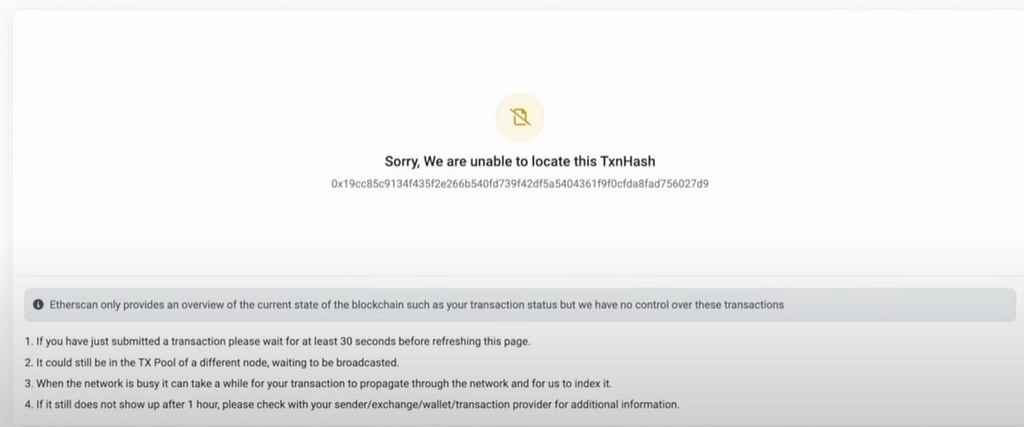
Source: Unibot Official
2. Token Economics
The project had a fair launch, with 100% of the token supply added to liquidity at launch. The total supply is 1 million, fully circulating and non-dilutive.
Why buy UNIBOT? Holding UNIBOT comes with a series of benefits, such as getting trading discounts when using the product, earning income from the entire platform and referrals. Due to these benefits, users and investors of Unibot are motivated to buy and hold as much UNIBOT as possible. This process increases the overall platform’s revenue and raises the token price, attracting more people to participate.
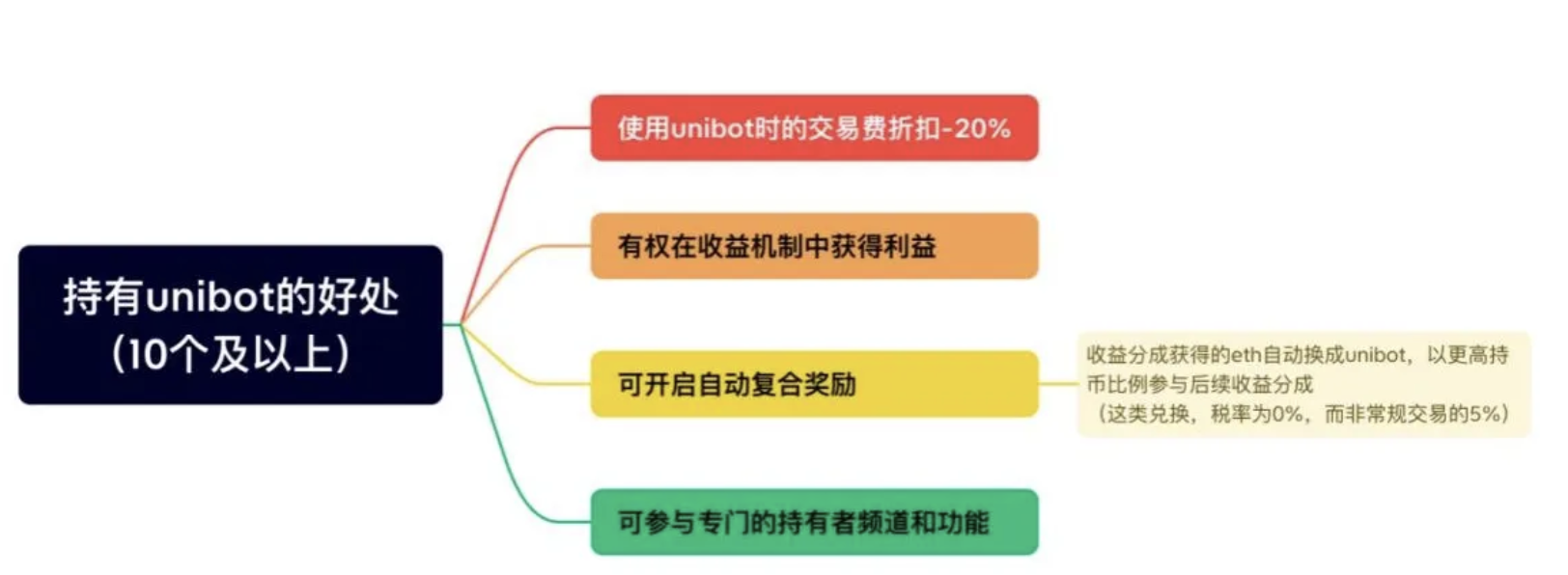
Source: LD Capital
What is the specific profit mechanism of UNIBOT? There are two main types of fees: fees for using bot products and taxes on token transactions. The fee distribution provides a higher proportion to token holders, giving the token some intrinsic value and promoting token holding. The 25% referral mechanism also encourages token holders to invite more new users to join the Unibot platform.

Source: LD Capital
Unibot’s introduction of an attractive token economics design is a key reason for the project’s popularity. Token holders want to profit from UNIBOT revenue sharing and price increases, and the path to achieving this is by accumulating more tokens and recommending more people to use and trade. To sustain this spiral, the project needs to ensure two things: continuous iteration and operation of products to ensure actual usage and new user entry into the platform, otherwise it will become a meme coin; and decent market-making and marketing capabilities to make token trading volume and price attractive.
3. Data Performance
The total market value of the entire Crypto bots sector is only about $200 million. UNIBOT’s MC and FDV (*fully diluted valuation) are $100 million, accounting for 50% of the total market value of the sector, making it a benchmark for the development of the sector. The top ten holding addresses account for about 18% of the total supply, indicating a very decentralized distribution of tokens. The price increased nearly 100 times from its lowest point of $2.46 in May to a peak of $236.98 in August, leading a wave of Telegram bots frenzy.

Source: coingecko
In terms of revenue, the highest daily income appeared on July 23rd, reaching 337.54 ETH. After a decline from the peak, the daily income has recently returned to the range of 100-200 ETH, with a cumulative total income of 7649 ETH. EPS is $42.51, and the recent P/E ratio has dropped from above 3 to 1.85, indicating an increase in investment value. In terms of income composition, Taxfees account for 79.93%, while Botfees account for 20.07%, indicating a relatively low proportion, leaving room for further optimization.
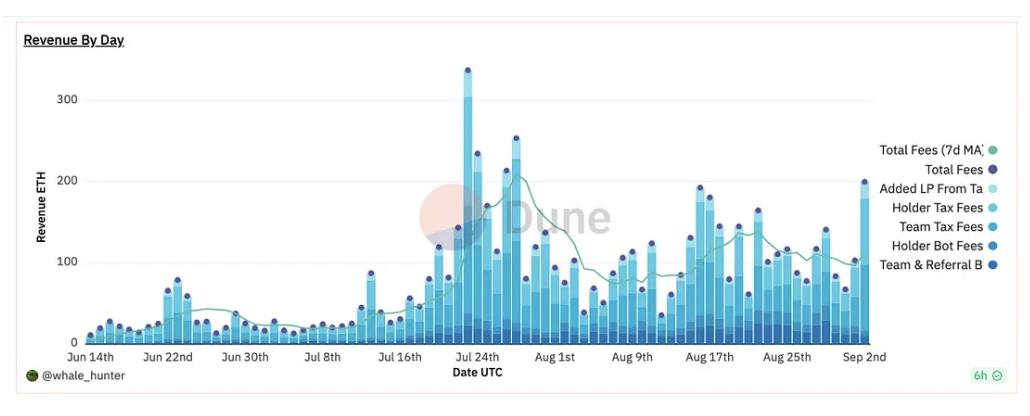
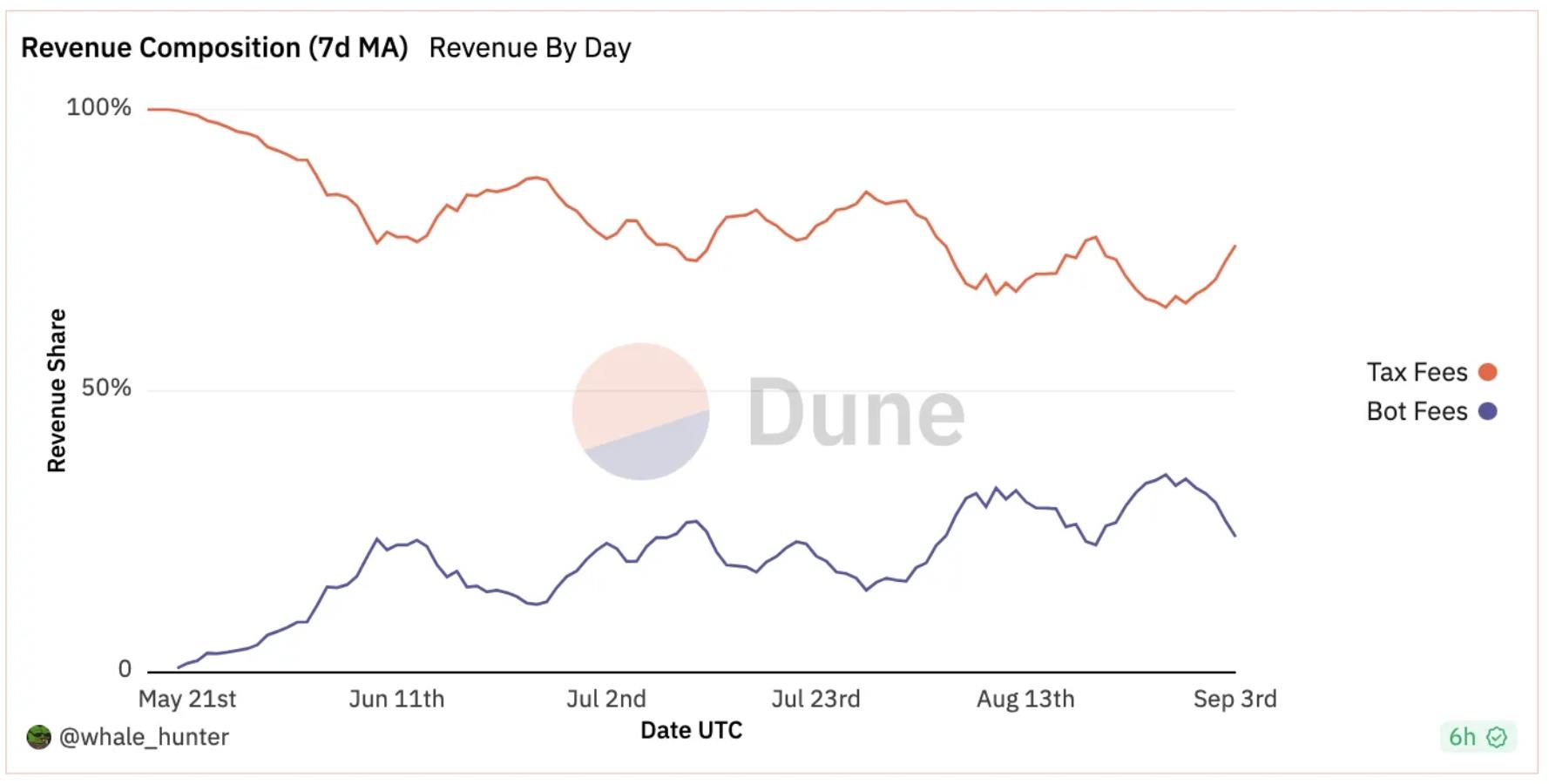
Source: Dune
UNIBOT has accumulated a trading volume of over $290 million, with 428,000 transactions and an average daily trading volume of about $4 million. It has performed well recently. The number of bot users is 143,500, with 1,808 active users in the past 7 days. The daily number of users is around 1,000, and the daily number of new users is around 100. As a leading project in the bots sector, the number of daily active users is relatively small compared to other leading projects in other sectors. If there is a significant and stable increase, the token price may surpass the previous high.
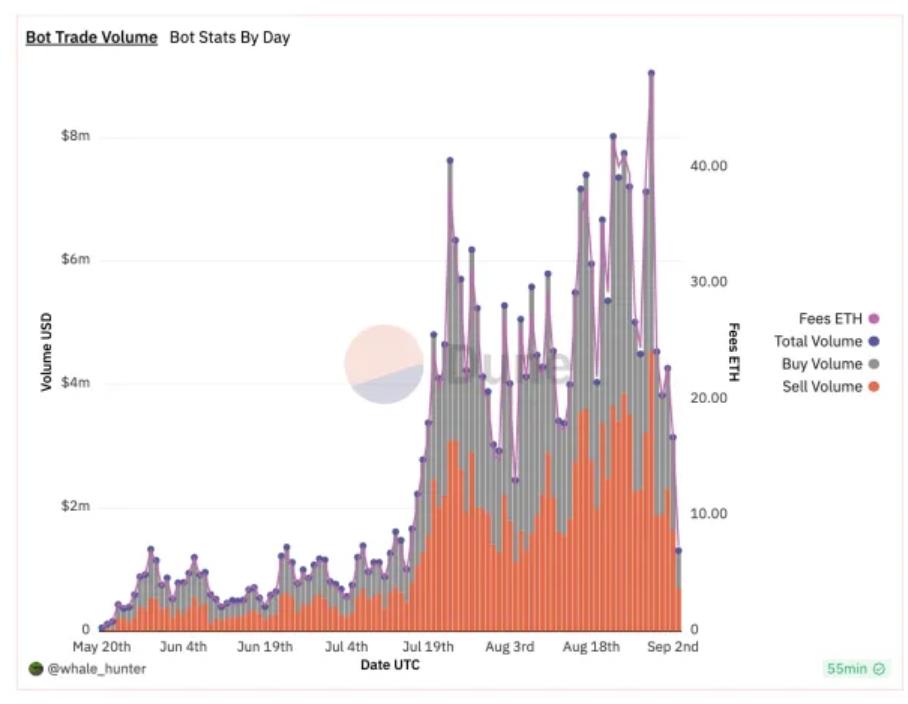

Source: Dune
4. Project Features
- First to introduce an attractive revenue mechanism, which is the core driver of price increase: Unibot is not the first to offer automated trading bot functionality, nor does it have the most users. Maestro had the most users before, but Unibot has the most effective token economics design. It attracts a large number of users to hold tokens and share revenue through a Ponzi-like model, and invites more users to participate. The binding and distribution of interests are the core drivers of rapid price increase.
- Provides practical core functions that need to be solved by bots, improving the efficiency of dex to some extent: Features such as copy trading and sniper trading introduced by Unibot do require automated operation to achieve high efficiency. These functions were previously mainly completed by professional quantitative traders. Now individuals can also achieve them through bots like Unibot, which also gives some advantages to using Dex compared to Cex.
- As a leading project, there is room for further improvement in security and reducing user barriers: Market investors have general concerns about the security of trading bots because the private keys are automatically called by the bot. How to prove security and decentralization to users is crucial for attracting a large amount of funds to this type of bots. In addition, many bots are based on high-traffic platforms such as Telegram and Discord, and it is believed that it will be easy to attract users from outside the crypto market. However, the current use of trading bot products is deployed through simple clicks, inputs, and conversations, rather than intuitive front-end interfaces that allow users to quickly understand. It requires clear trading logic and trading experience to quickly get started. Currently, bots are icing on the cake for experts rather than lowering the threshold for novices.
- Substantial income, obvious first-mover advantage, and more opportunities to sustain the business model: The current trading bots are starting to incorporate token economics similar to UNIBOT’s revenue mechanism, which can create a rapid spiral increase in token price. However, to maintain it in the long run, the combination of product capabilities, market-making capabilities, and marketing and operational capabilities is needed. Currently, the user base, active user count, and bot fee proportion of leading projects like Unibot are not high, and the data of many other projects are even more lackluster. Unibot has the advantage of being a first-mover and having high revenue, and it has more opportunities to continue to exert efforts in product and operations to achieve long-term development, such as the recent release of Unibot X, which provides a more intuitive front-end interface and better user experience.
III. Subcategory Tools – Lootbot
Lootbot is a bot dedicated to executing potential airdrop interactions. It is based on the Telegram platform and serves as a simplified frontend for multiple chains. It deploys and automates on-chain interactions through conversations. It can save users a lot of time and energy in highly repetitive work and is designed with anti-witch mechanisms to efficiently achieve airdrop goals. Currently, it mainly supports the actual interactions of Zksync and Linea, and will later enrich the interaction support for other chains such as Layerzero, Scoll, and Base. The possible interactions include bridge, swap, NFT minting, etc.
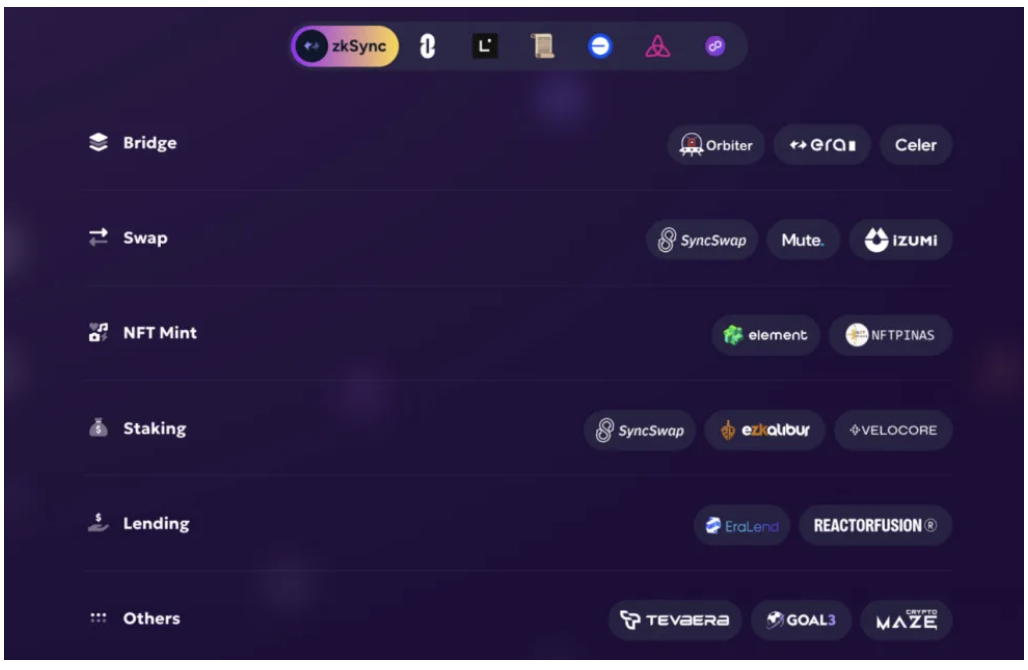
Source: Lootbot Official
Other subcategory tools include Collab.Land (community management), Bridge Bot (cross-chain), WallyBot (wallet analysis), NeoBot (crypto analysis and tracking), TokenBot (community trading tool).
1. Core Functions
- Wallet Deployment and Network Selection
First, you can create up to 10 wallets for airdrop task interactions. Second, after creating a wallet, provide at least 0.1 ETH in funds for each wallet on the Ethereum mainnet (*it is recommended to transfer from CEX to avoid witch detection). Third, bridge your funds from the Ethereum mainnet to the selected chain to start looting.
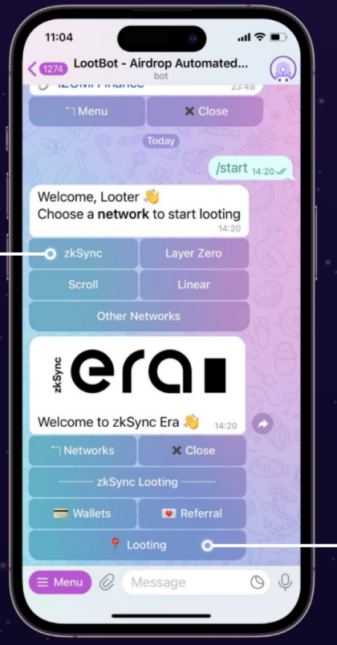

Source: Lootbot Official
- Automated Airdrops:
After starting the loot, the task interactions will be automated by the bot, saving users a lot of time and energy in repetitive work. Generally, airdrop tasks are triggered once a week, and lootbot will choose the time with the lowest fees to execute the airdrop routes. The selection of tasks and routes for airdrop tasks will be advised by Lootbot’s consultants and approved by the team. Users can view the corresponding interaction data of the wallet after the loot begins.
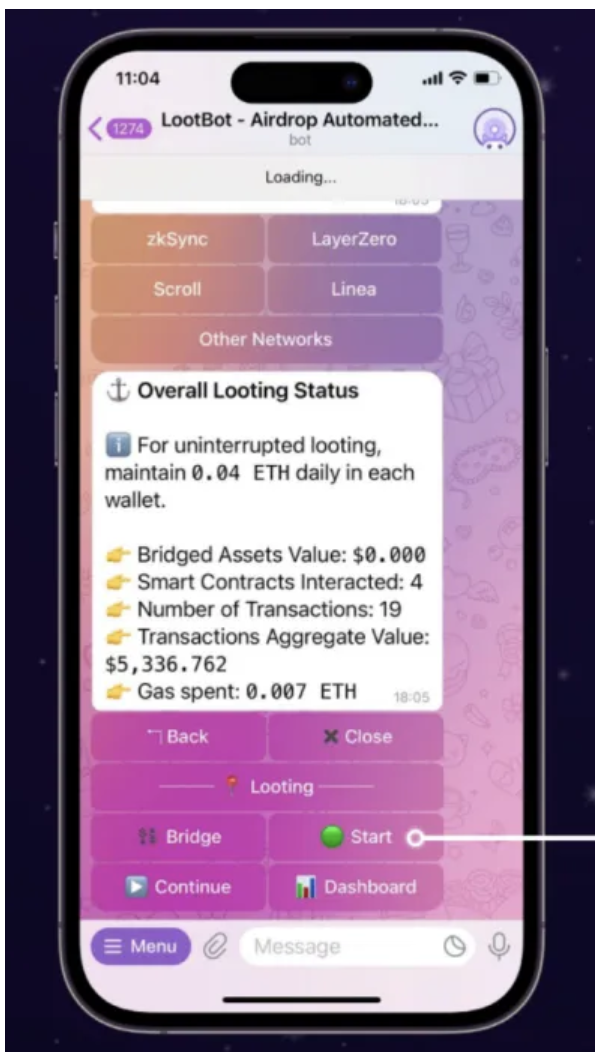
Source: Lootbot Official
- Integrated Transactions:
In addition to looting, Lootbot also integrates transaction functions, allowing direct trading of all ERC-20 tokens on Lootbot via Telegram. Unlike airdrop wallets, a maximum of 3 wallets can be created for transactions.
- Anti-Witch Detection
By providing different planned routes to prevent witch attacks and represent genuine on-chain interactions, thereby maximizing the chances of qualifying for airdrops, Lootbot adopts methods such as random strategies, hiding on-chain activities, hiding fund flows, and automatically mixing funds with CEX to avoid being identified as a witch.
2. Roadmap
Lootbot is still a relatively early-stage project. In the second quarter of this year, it conducted fundraising and research and development. In the third quarter, it launched the official version and the LOOT token. This year, Lootbot will integrate more chains and protocols, as well as more automated tasks, and focus on recommended market marketing.

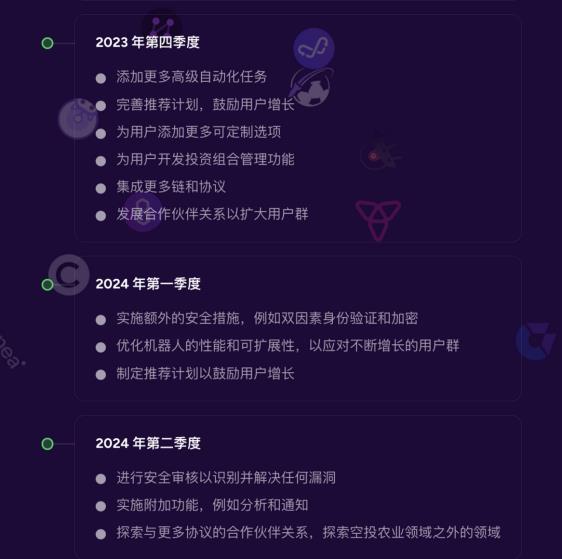
Source: Lootbot Official
3. Token Economics
The total supply of LOOT tokens is 10 million. 50% of them are sold to seed investors, 40% are used for adding liquidity, 5% are allocated to the team, and 5% are listed on cex. The team’s portion has a TGE ratio of 0 and will have a cliff unlock after 6 months, followed by a linear unlock after 9 months. The seed portion has a TGE ratio of 33% and will have a linear unlock after 1 month.
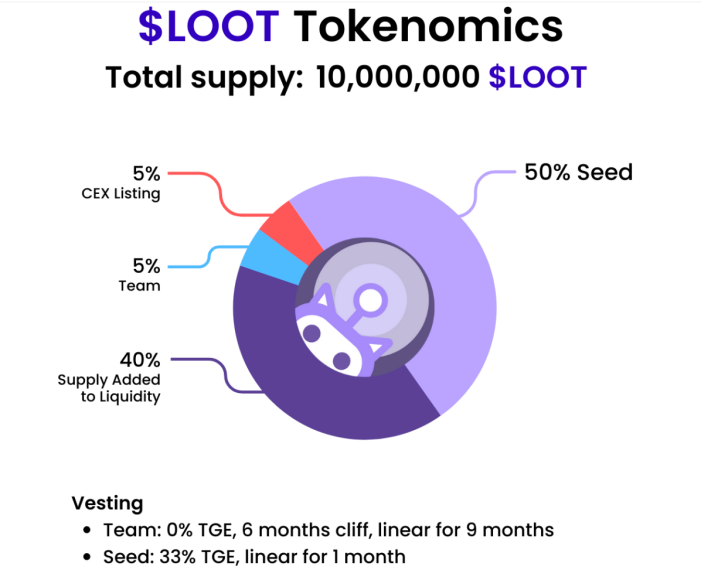
Source: Lootbot Official
Why use LOOT and hold LOOT? Similar to UNIBOT, holding LOOT allows you to enjoy self-subscription discounts and participate in profit-sharing mechanisms, earning income from other people’s paid products.

Source: LD Capital
How does the profit-sharing mechanism of LOOT work? The expenses of LOOT come from two parts: the monthly subscription fees used by Lootbot and the transaction tax of LOOT tokens. 75% of the subscription fees are used to distribute profits to token holders. After 6 months of product launch, 2% of the transaction tax starts to participate in profit distribution. Lootbot introduces the concept of “epochal income”, where the allocated profits will be aggregated into epochal income. 33% of the epochal income is distributed to LOOT holders only, and 66.7% is distributed to holders of both LOOT and XLOOT. The entire epochal income will not be distributed within one epoch (*24 hours), but will be distributed in subsequent epochs. According to the project team’s idea, this method aims to create a more stable and consistent reward distribution, reducing the impact of fluctuations that may occur when sharing income in a single instance.

Source: LD Capital
The current circulating supply of LOOT tokens is 8.7 million, accounting for 87% of the total supply. The market cap is 3.48 million, and the fully diluted valuation is 4 million. The ATL appeared on July 17th at $0.19, and the ATH appeared on July 20th at $1.3. The top ten holding addresses account for approximately 36% of the total supply.
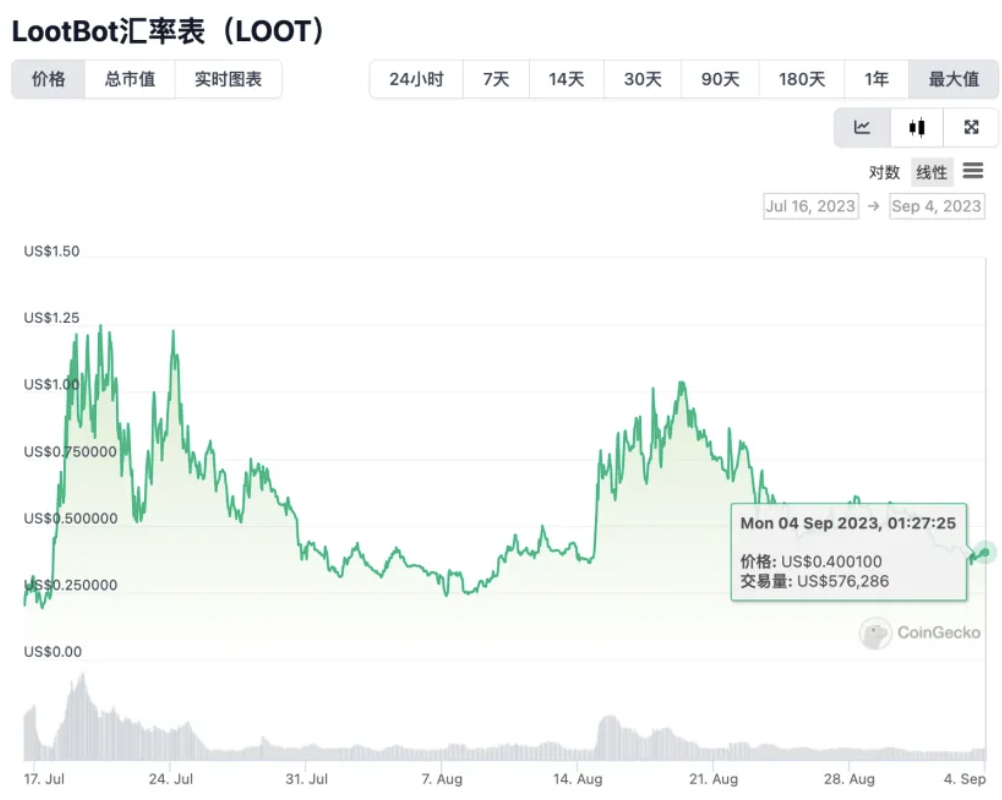
Source: coingecko
4. Project Features
It also introduces a revenue mechanism similar to Unibot, but the source and distribution of revenue are different. The price driving force is weaker than UNIBOT: Similar to Unibot, the revenue comes from service fees and token transaction taxes. However, Unibot’s service fee is a commission for each transaction, which means that it will be generated immediately when trading; Lootbot’s service fee is a subscription fee. Free users of the platform do not pay the subscription fee, but instead compensate with airdrop shares received in the future, which is a future uncertain income. Paid users of the platform pay a monthly fee. The time and frequency are relatively weak, and the distribution of revenue requires multi-epoch linear distribution, which extends the time dimension of revenue generation. In terms of driving the rapid rise of token prices, it will be weaker than UNIBOT. However, due to the different types of bot products and operations, the distribution method of Lootbot may be more suitable for itself in the long run.
Airdrops strongly rely on the use of bot tools, and Lootbot focuses on the subdivision of airdrop tools and has become the leading project in this field. There are many bots for trading and DeFi, but there are very few airdrop bots used by individual users. Airdrop tasks are mostly highly mechanized and repetitive. Without the use of bots, individual users need to spend a lot of time and manual effort to constantly repeat the tasks. Additionally, their parallel processing capability is weak, and the future income is highly uncertain. The bot provided by Lootbot can greatly meet the needs of individual users.
4. GPT and AI Category – ChainGPT
ChainGPT is an advanced artificial intelligence model and tool specifically designed for blockchain technology and encryption-related topics. Its featured functions include: blockchain and encryption information, no-code smart contract generator, smart contract auditor, AI NFT generation, ChainGPT (*first-layer blockchain) virtual machine, etc. In addition, ChainGPT’s SDK and API services can be integrated into existing applications.

Source: Chaingpt official website
Other examples of this category include All In (*AI trading), Image Generation AI (*AI-generated NFTs), NexAI (*a series of AI tools), BlackSmith (*AI analysis), TrackerPepeBot (*AI analysis and smart contract security testing), etc.
1. Core Functions
- ChainGPT Chatbot: A conversational AI assistant that solves blockchain technology and cryptocurrency-related problems through dialogue, such as no-code smart contract programming, debugging, market analysis, guidance, and trading. It is suitable for individuals, developers, and businesses in the cryptocurrency market. It can be used on multiple platforms such as Telegram, Discord, and the web.
- AI News: Provides AI-driven news services that scan the Internet every 60 minutes and automatically generate news articles in the blockchain and cryptocurrency field. This service aims to provide users with the latest and accurate information about the industry’s latest trends and developments.
- Smart Contract Generator and Auditor: ChainGPT simplifies the creation and auditing of smart contracts and is user-friendly for people with no coding experience. Users can generate contracts by describing the desired functionality or quickly audit existing contracts by pasting the code into ChainGPT.
- AI-generated NFTs: Using AI algorithms, NFTs can be created based on user prompts and can be used for various applications such as digital art, in-game items, and digital collectibles. Within 30-60 seconds, anyone can deploy their NFTs on the blockchain.
- ChainGPT LianGuaid: ChainGPT LianGuaid is a decentralized fundraising platform for incubating crypto projects, and it can be used for IDOs. Community members who hold CGPT tokens can participate in IDOs, receive airdrops, and have access to early-stage projects, among other benefits.
- ChainGPT (*first-layer blockchain) virtual machine (under development): The ChainGPT virtual machine provides a unique combination of EVM compatibility and on-chain AI, aiming to support the development of decentralized AI applications on the blockchain.
There are SDK and API access, blockchain analysis, AI trading, AI security extension, and other functions that can be tested and used through permission applications.
2. Development and Roadmap
The ChainGPT team was established in 2022 and consists of experienced developers, blockchain engineers, and AI engineers. The CEO and founder of ChainGPT is Ilan Rakhmanov, and the development team is led by Dr. Adnan Tariq, an award-winning blockchain and AI engineer. The team is engaged in the planning and design of complex AI models and showcases AI research results to large tech companies and entrepreneurs. In 2022, the team created a chatbot based on ChainGPT and published a research paper (*v1.0 whitepaper). On August 25, 2023, ChainGPT announced receiving a $350,000 grant from Google and obtained support from Google Cloud Computing and other resources, which will be used for processing and enhancement of the ChainGPT AI model. ChainGPT claims to have received investments from multiple parties, including private investors, venture capital firms, and strategic partners. However, specific information about the investors behind the project has not been publicly disclosed.

Source: ChainGPT
In the first three quarters of 2023, ChainGPT released the beta and official versions of the ChainGPT chatbot, DevAssist browser extension, Stake & Farming DApp, ChainGPT News, iOS and Android chatbot applications, Telegram/Discord/Slack AI chatbots, and the CGPT token.
In the fourth quarter of 2023, ChainGPT will continue to improve the AI model and add features. This includes the ChainGPT AI trading assistant, ChainGPT iOS and Android app versions with integrated CGPT wallet, and upgrades to the AI NFT generator.
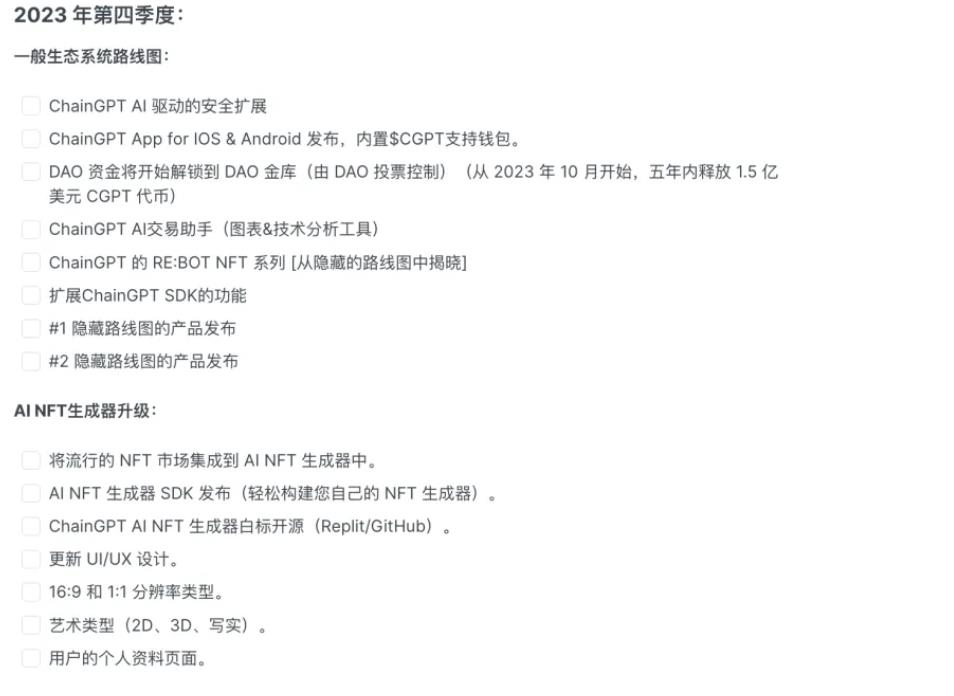
Source: ChainGPT Official
In 2024, the ChainGPT team will focus on building and launching the ChainGPT testnet and mainnet, creating a Layer 1 and Layer 2 network suitable for AI smart contracts and models.

Source: ChainGPT Official
3. Token Economics
The total supply of CGPT tokens is 1 billion, with the following distribution: private sale a-11.4%; private sale b-4.5%; public-9%; liquidity-20%; team-9%; development-4%; consulting-3%; dao-9%; reserves-9.85%; marketing-9%; kol-6.25%; liquidity mining-5%. The current real-time supply is 129,024,329 tokens, with a release ratio of 12.9% (*including LP).
CGPT tokens have four main use cases:
- Consumption in specific functions: Accessing the ChainGPT AI model, an advanced artificial intelligence model designed specifically for the cryptocurrency and blockchain industry, providing users with functions such as contract writing assistance, concept interpretation, answering questions, and market analysis.
- Burning mechanism: CGPT has a burning mechanism that automatically consumes half of the fees or revenue generated by ChainGPT tools and utilities. This reduces the overall supply of CGPT and increases its scarcity. Currently, 1,294,904 tokens have been burned (* approximately 0.12%).
- Staking: Staking allows token holders to contribute to the security and stability of the network by locking their tokens and receive rewards or certain benefits within the ecosystem. In the case of ChainGPT, staking allows token holders to access the AI model and have priority access to its services. They can also gain governance rights in the Dao and increase their membership level in ChainGPT LianGuaid (* Bronze, Silver, Gold, Diamond) to gain greater participation privileges in LaunchLianGuaid.
- Liquidity provision: Token holders can earn rewards by providing liquidity to the ecosystem. In the case of ChainGPT, token holders can provide liquidity to the CGPT token on decentralized exchanges and receive rewards in CGPT tokens.
Currently, CGPT has a market capitalization (MC) of $6.52 million and a fully diluted valuation (FDV) of $50.54 million. The token price, after experiencing an initial surge in April this year, gradually declined to a new low level. The all-time high (ATH) occurred on April 29th at $0.297, and the all-time low (ATL) occurred on September 3rd at $0.0492.
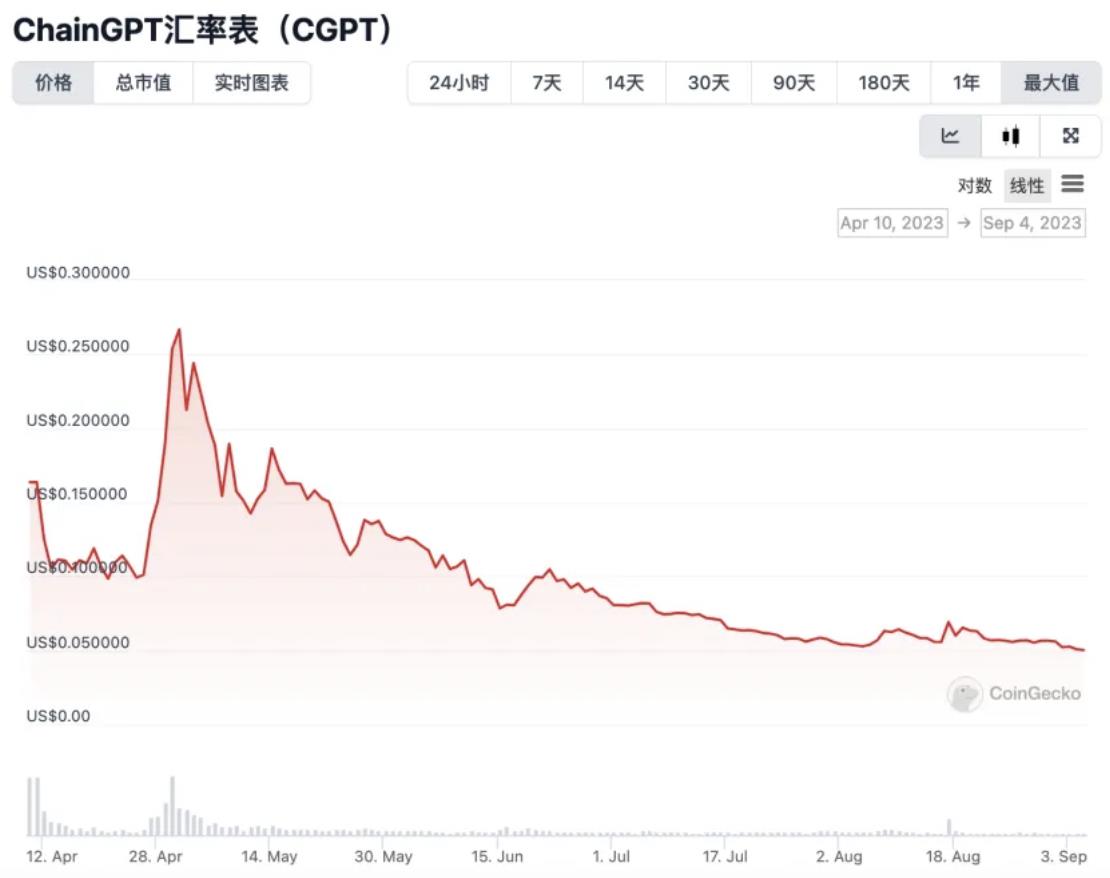
Source: coingecko
4. Project Features
ChainGPT combines bot and AI technologies to provide many efficient tools. For example, with the ChainGPT chatbot, users can specifically address blockchain technology and cryptocurrency issues. With the smart contract generator and auditor, users can generate the required smart contracts and perform audits without requiring extensive programming knowledge. With the NFT AI generator, users can generate and deploy their NFTs on the blockchain within 30-60 seconds.
ChainGPT has built a comprehensive product matrix that, when successfully implemented, can form a closed loop and create competitive barriers. ChainGPT has developed many AI tools applicable to the crypto industry. For example, developers can develop using ChainGPT, publish on ChainGPT LianGuaid, and users can participate in token sales by holding CGPT tokens. They can also use ChainGPT for smart trading, browse news, consult GPT on blockchain and crypto-related questions. ChainGPT is also developing its own separate chains (* Layer 1 and Layer 2). Once all of these are successfully implemented, it will have strong competitive barriers, but the time and difficulty of implementation are also significant challenges.
Section 5: Summary and Reflection
By analyzing various cutting-edge projects in the field of crypto bots, it is evident that crypto bots effectively address certain pain points for crypto users. These pain points include copy trading, sniper trading for new coins, automated airdrop interactions, AI-generated smart contracts or NFTs. Without relevant bots, individual users would find it difficult to gain a competitive edge. The rise in popularity of Unibot in this round of development has drawn attention from investors and users alike, resulting in the rapid emergence of new projects within one to two months. Each project has its own highlights. Driven by real demand, crypto bots will evolve into a brand-new track.
Currently, the market value of the entire track is relatively small, totaling around 200 million US dollars. Compared to other mature tracks, there is still significant room for growth. Long-term development requires the following factors: product iteration to lower barriers and provide better user experience, improved asset security and decentralization, and a larger user base.
In conclusion, projects that address user pain points will have long-term development prospects. The token economics of bots have also opened up new ideas for capital and price empowerment. Paying attention to new products and iterations will provide opportunities to capture the next round of market growth.
Like what you're reading? Subscribe to our top stories.
We will continue to update Gambling Chain; if you have any questions or suggestions, please contact us!